|
|
By Sandy, on November 30th, 2009
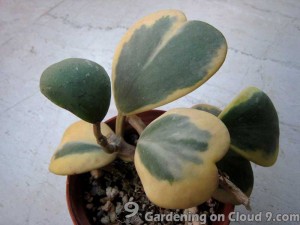 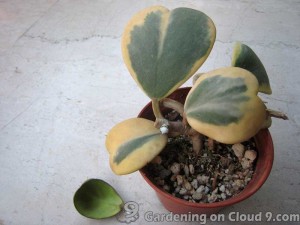
As said in an earlier post, my Hoya Kerrii had grown a new leaf. But unlike the other leaves of my Hoya Kerrii, this one was all in green. While I was wondering if the edge of the leaf would somehow turn yellow as the leaf grew bigger, I read an excellent post about Hoya Kerrii in Plants are the Strangest People (thank you Stephanie 😀 ).
In the post, Mr Subjunctive, the author, suggests to remove all the stems with all-green leaves. He explains that because a stem with all-green leaves has an advantage over a variegated one, with enough time, the all-green leaves will eventually take over the whole pot ! Continue reading Hoya Kerrii – Should I or Should I Not?
By Sandy, on November 26th, 2009
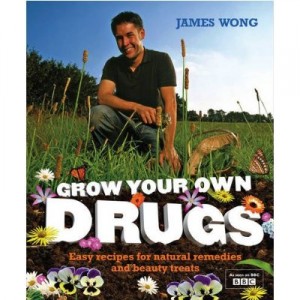
Last night Yik called and told me that there was a program showing on TVB Pearl that might be of my interest. So I turned on the tv and watched the program, and yes, it surely is my cup of tea.
This program is called Grow Your Own Drugs, a six-part series presented by James Wong, an ethnobotanist trained in Kew Garden. James shows us how we can make simple, natural remedies to help ease the symptoms of some everyday ailments with plants which can be found in our gardens or flower shops. In the program, James shares some amazing recipes, from Marigold lotion for motorizing skin and clearing acnes, to Viola eczema cream and Elderflower lozenge. Continue reading Grow Your Own Drugs
By Sandy, on November 16th, 2009
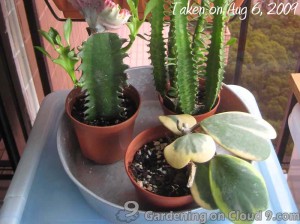
I bought this Hoya Kerrii (aka Sweetheart Plant) a few months ago in the summer. Although I know that Hoya Kerrii is a slow-growing plant like most other succulents, I observe it closely every once a while, and hope that I will find something new, something different and exciting on this Sweetheart Hoya.
And last month, I finally got to see some “action” – my Hoya Kerrii has grown another heart-shaped leaf! Unlike the other leaves of my Hoya Kerrii, this one is all in green. Now I wonder if the edge of the leaf will somehow turn yellow as the leaf grows bigger. Continue reading My Hoya Kerrii Has Grown Another Heart
By Sandy, on November 12th, 2009
There are several bags of blossoming impatiens hanging in the bonsai workshop. Instead of potting in typical hanging baskets, the impatiens are planted in huge, black rubbish bags. And because the impatiens are blooming so vigorously, the rubbish bags are mostly covered with impatiens flowers and can hardly be seen.
These hanging impatiens bags look so pretty and easy to maintain that I really wanted to make one of my own once I spotted them in the bonsai workshop. And here, after getting some instructions and advices from Teacher Wong, I have made my own last week 🙂
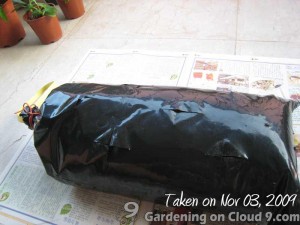
First challenge: Finding a thick and strong garbage bag. Once I got the container for my plants, I filled it up with potting mix and tied it up tightly. Then, with a cutter, I made a few openings for my impatiens.
Make sure not to make the openings too close to each other, for we want to give the impatiens enough space to grow and flower.
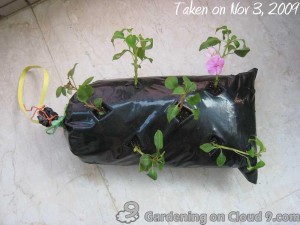
Continue reading Growing Impatiens in a Rubbish Bag
By Sandy, on November 9th, 2009
I have got two baby Vendas from an orchid class earlier. Like many other orchids, Vendas can be grown on rocks, stones, wooden rafts, etc. And since I have never tried to grow orchid in any other way besides in pot with perlite, of course, I would love to take this chance and try something that I have never done before 😀
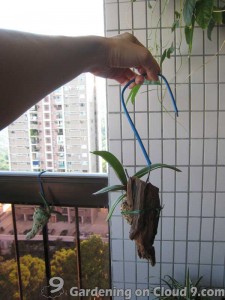 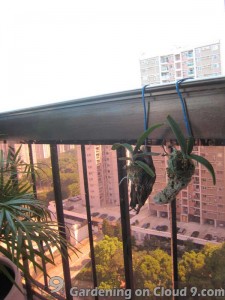
Continue reading My Hanging Vandas
By Sandy, on October 29th, 2009
There is one thing we should keep in mind when fertilizing our plants – the more isn’t the better. Even though I knew this rule-of-thumb very well (I thought I did…) and practiced what I preached (for most of the time), recently, I’d over-fertilized my African violet – Frosted Denim – and burnt most of its flower buds 🙁
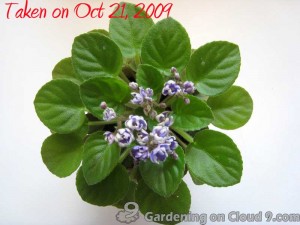 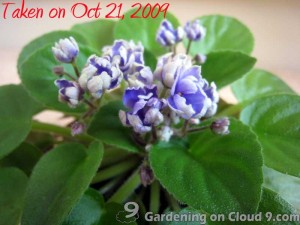
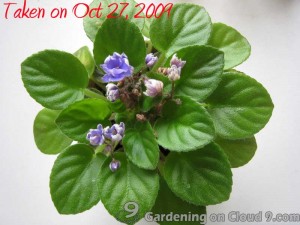 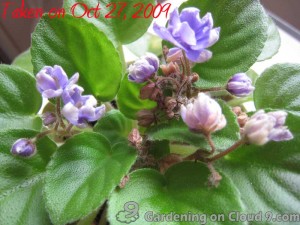
Real Life Example of Bad Fertilizing Practice
A few weeks ago, my African violet – Frosted Denim – was growing beautifully with many flower buds. Since African violets like to be continually fertilized during their blooming period, I diligently fed mine in a regular basis with diluted fertilizer. Continue reading Plant Fertilizer – When More Isn’t Better
By Sandy, on September 27th, 2009
Last week, I had finally tasted the yellow skin watermelons that were growing in the greenhouse like hanging lanterns for the first time.
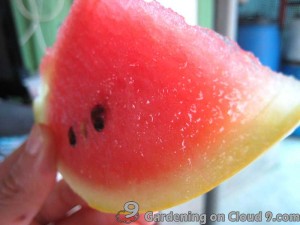
The flesh and seeds of the watermelon looked just like a regular one, only that it tasted so sweet. Indeed, Teacher Wong told me that this is an award-winning watermelon developed by a breeder/producer in Taiwan. Continue reading Yellow Skin Watermelon
By Sandy, on September 21st, 2009
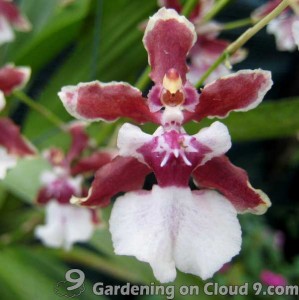 The number of orchid species is about four times the number of mammal species, or more than twice the number of bird species. The number of orchid species is about four times the number of mammal species, or more than twice the number of bird species.
Bulbophyllum (石豆蘭 in Chinese), Cattleya (嘉德麗亞蘭), Paphiopedilum (aka Slipper Orchid, 拖鞋蘭), Vanda (萬代蘭), Dendrobium (石斛蘭), Phalaenopsis (蝴蝶蘭)… there are just too many orchid species that it seems like a mission impossible to tell apart the different species of this beautiful flowering plant.
But after I saw the blooming of Oncidium orchid (aka Dancing Lady, 文心蘭) a few days ago, I believe that from now on, at least I will be able to recognize the Dancing Lady from all the rest 🙂
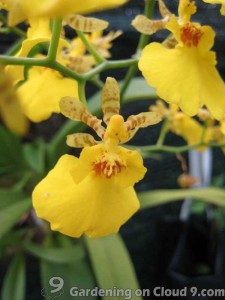
Continue reading Oncidium Orchid – the Dancing Lady
By Sandy, on September 17th, 2009
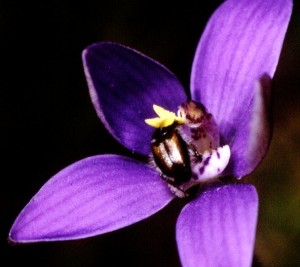
We, women, sometimes complain that men only care about food and sex but nothing else (okay, also football games and gadgets). While it can be quite frustrating and disappointing sometimes, we can also try to be more sympathetic, and understand that these poor guys can really do nothing but try to meet their human biological needs. Food, sex, water and air are the four very basic biological needs that the survival of human race will become impossible if any one of these needs is not met.
It is just part of the nature. All animals know these biological needs, as well as all insects. And apparently, even orchids know this very well too. Indeed, the orchids understand this so well that the plants use these biological needs to lure different insects to work for them for free! Continue reading It’s Always about Food & Sex
By Sandy, on September 14th, 2009
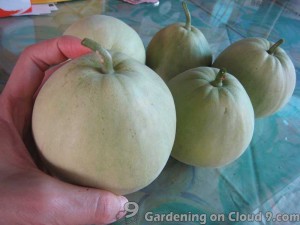 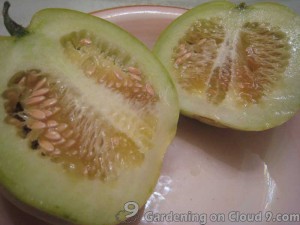
After weeks of anticipation, the 梨瓜 (lee gwar, literally means “pear melon”) in the greenhouse have finally ripened, and I’ve finally got the chance to find out what these mysterious melons actually are.
So these are not chayote, as I have guessed. In fact, I have never seen this fruit before. It is like a fuji-apple-size honeydew melon. The fruit has a smooth greenish-white peel, pale green flesh, with seeds in the center. It actually tastes a bit like honeydew melon, only that it is not as sweet, yet much crunchier. Continue reading The Mysterious Melons
|
|













 The number of orchid species is about four times the number of mammal species, or more than twice the number of bird species.
The number of orchid species is about four times the number of mammal species, or more than twice the number of bird species.






Recent Comments